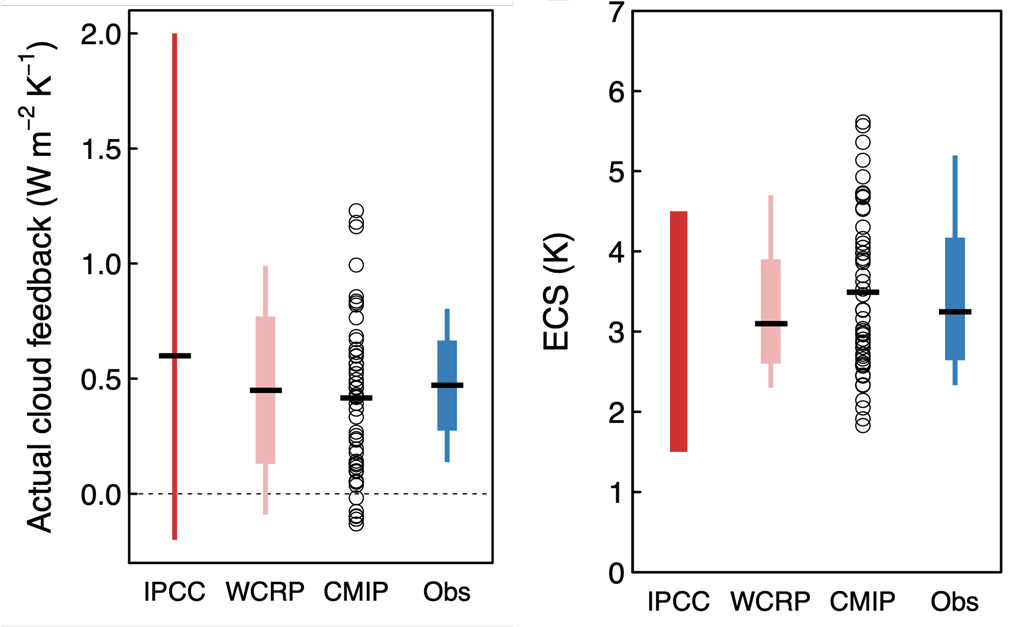
Clouds study finds that low climate sensitivity is ‘extremely unlikely’
Ayesha Tandon
07.21.21Ayesha Tandon
21.07.2021 | 10:41amIt is “very likely” that the way clouds change as the world warms will drive further temperature rise, a new study finds.
The response of clouds to a change in global temperature – known as the “cloud feedback” – plays a crucial role in how much the planet will warm. However, estimates of cloud feedback are uncertain. The new study, published in Proceedings of the National Academy of Sciences, uses global satellite observations to reduce this uncertainty.
Taking their findings into account, the authors produce a central estimate of equilibrium climate sensitivity (ECS) – the global temperature change resulting from a doubling of atmospheric CO2 – of 3.2C. They add that low ECS values below 2C are “extremely unlikely”.
While much of the existing literature on cloud feedbacks focuses on specific cloud types or geographic regions, this paper presents the first global observational estimate of cloud feedback, the authors say.
A scientist not involved in the research tells Carbon Brief that “this is a really clever study”, adding that it is “the best one I have seen that combines models and observations to narrow down cloud feedbacks”.
Equilibrium climate sensitivity
Clouds are a complex part of the climate system, driving a range of processes that can heat up and cool down the planet. While clouds currently have an overall cooling effect, global warming could trigger subtle changes in cloud properties that either enhance or reduce their cooling effect. This is the “cloud feedback”.
For scientists researching the climate sensitivity of the planet, it is crucial to accurately assess the global cloud feedback. However, clouds are tricky to model – and cloud feedbacks are currently the biggest uncertainty in calculating ECS.
In 2013, the Intergovernmental Panel on Climate Change’s (IPCC) fifth assessment report (AR5) concluded (pdf) that the “net cloud feedback” is likely positive. The report produced a central estimate of +0.6 Watts per metre squared per degree C (W/m2/C), with an uncertainty range between -0.2 and +2.0 W/m2/C.
The report’s climate sensitivity estimate suggested a range of 1.5C and 4.5C. According to the IPCC, “differences in the response of low clouds to a warming are responsible for most of the spread in model-based estimates of equilibrium climate sensitivity”.
Since the publication of the AR5, climate scientists have used models from the sixth Coupled Model Intercomparison Project (CMIP6) to produce further estimates of both cloud feedback and ECS. And, more recently, a World Climate Research Programme project on clouds reduced the cloud feedback uncertainty.
The new study takes another step towards reducing the uncertainty in cloud feedback estimates. The authors use monthly global satellite observations to infer how clouds respond to various environmental factors, then apply a “machine learning” technique to analyse the results.
Positive feedback
The plots below show the cloud feedback (left) and ECS (right) ranges presented by the IPCC AR5 report (red), WCRP (pink), a combination of CMIP5 and CMIP6 models (black) and the new paper (blue). The black line shows the central estimate for each range.

The study finds a central cloud feedback estimate of 0.43W/m2/C with a 90% confidence range of ±0.35. This result reduces the uncertainty in cloud feedback values by 68% compared to the IPCC’s “very likely” range, and by 35% compared to the WCRP range.
The findings suggest there is less than a 2.5% chance that the cloud feedback is negative, explains Dr Tapio Schneider, a senior research scientist from NASA’s Jet Propulsion Laboratory who was not involved in the research. He tells Carbon Brief:
“Their analysis rules out that clouds globally dampen global warming; almost certainly, they amplify global warming. Interestingly, though, their analysis also suggests that a very strong amplifying feedback of clouds on warming is unlikely. The latter part is good news: it is another piece of evidence suggesting that the extremely high climate sensitivities seen in some recent climate models may not be consistent with Earth observations.”
The authors estimate a central ECS value of 3.2C, with a 17% to 83% range of 2.6 to 4.2C. This is “considerably narrower” than the range given by the IPCC, but “agrees well” with the WCRP value, according to the study. Crucially, this constraint also suggests there is just a 0.5% chance that the ECS is less than 2K – making this possibility “extremely unlikely”.
Dr Daniel McCoy, an assistant professor at the University of Wyoming, tells Carbon Brief that this finding is “crucial” and “has important implications for how our planet is going to look in the coming decades”. He adds:
“What the authors have done in this paper is a step forward in our understanding of a positive global cloud feedback and is another line of evidence that supports the recent assessment report put forward by the WCRP.”
Dr Paulo Ceppi from Imperial College London is the lead author of the study. He tells Carbon Brief that these findings are also “very close” to those of a paper published last year, which assessed ECS using multiple lines of evidence and included “an expert assessment of cloud feedback”.
The lead author of the assessment – Dr Steven Sherwood, from the University of South Wales – compliments the new study, noting that its results line up well with his own. He tells Carbon Brief:
“This is a really clever study, the best one I have seen that combines models and observations to narrow down cloud feedbacks…Their results strongly support our all-evidence based assessment of climate sensitivity published last year.”
Key advances
The paper notes that multiple studies have estimated the cloud feedbacks of specific geographic regions or cloud types. However, Ceppi tells Carbon Brief that this study gives “the first observational estimate of global cloud feedback” – analysing all cloud types with global coverage.
To ensure that they include all cloud types in their analysis, the authors consider both longwave and shortwave radiation – a step that many prior studies did not take. This is important because the altitude of a cloud affects the types of radiation that it will interact with.
Prof Ellie Highwood – professor of climate physics at the University of Reading – explained the significance of different cloud types in her 2018 guest post for Carbon Brief:
“Low, bright clouds have a largely cooling influence because they reflect sunlight [shortwave radiation] away from the Earth’s surface. High, thin clouds composed of ice crystals are more or less transparent to sunlight, but do absorb outgoing infrared [longwave] radiation, re-emitting a small fraction and, thereby, warming the planet. What makes things even more complicated is that, in most places, there are multiple layers of cloud at any one time.”
Ceppi tells Carbon Brief that his work shows an “interesting discrepancy” compared to CMIP models:
“Our result suggests less positive longwave feedback and more positive shortwave feedback than in CMIP models. This could happen if the high cloud amount decreases more with warming in observations than in models. This is an interesting result that we intend to further investigate in future work.”
To reduce the uncertainty in their estimates of cloud feedback, the authors build upon a methodology used in previous studies known as “cloud-controlling factor analysis”, which assesses a cloud’s response to environmental factors including temperature, humidity and wind.
They then implement a “machine learning” technique called “ridge regression”, which allows them to separate out the effects of the different environmental factors on clouds. Ceppi tells Carbon Brief that the use of machine learning is a “key advance” of this study enabling “much more reliable predictions, relative to prior studies, using just 20 years of observational data”.
Using this machine learning method, the authors are also able to isolate the individual impacts of different environmental factors on the cloud feedback. They find that surface temperature and tropospheric stability – a lack of mixing in the vertical air column – are the most important factors driving the global cloud feedback.
Dr Yoko Tsushima, a scientist at the UK Met Office who was not involved in the study, tells Carbon Brief that this study presents “encouraging results”, and adds that the use of cloud controlling factors is likely to “accelerate” in the climate modelling community.
“It is remarkable that this can be done”, Schneider tells Carbon Brief. However, he adds that there is still work to be done:
“While this is a welcome study that helps us understand cloud feedbacks and narrows uncertainties about them, it leaves the central issue that has vexed climate modeling for decades in place: Cloud feedbacks are still too uncertain for comfort one way or another. We need climate models that simulate clouds much better than those we have.”
Ceppi et al (2021) Observational evidence that cloud feedback amplifies global warming, PNAS, doi:10.1073/pnas.2026290118
-
Clouds study finds that low climate sensitivity is ‘extremely unlikely’
-
Clouds are ‘very likely’ to amplify global warming, new study finds

